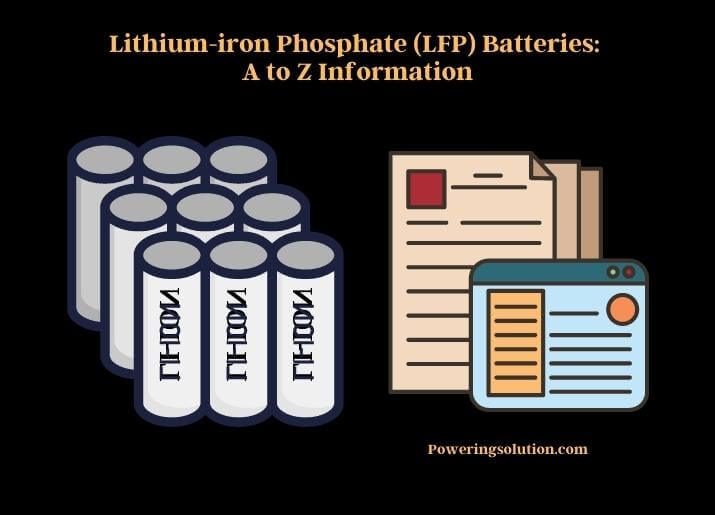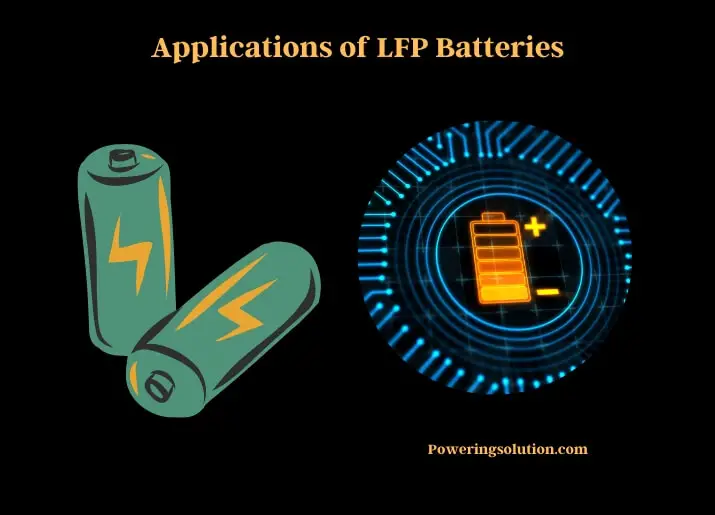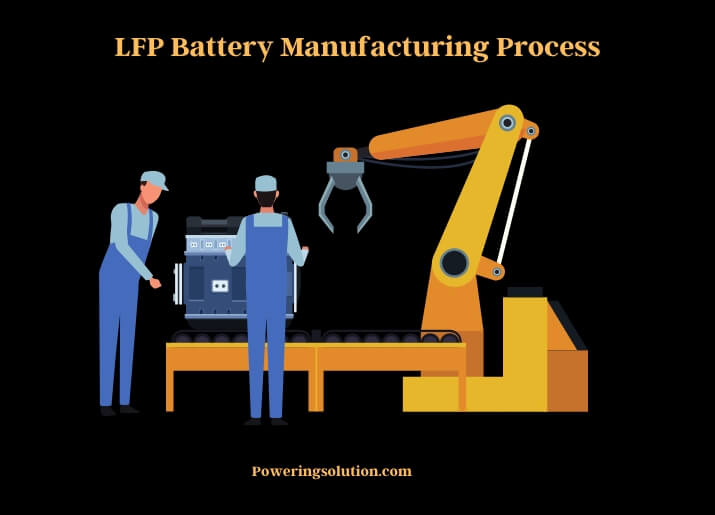As the world transitions towards a more sustainable future, the demand for renewable energy and electric transportation has been on the rise. Lithium-ion batteries have become the go-to energy storage solution for electric vehicles and renewable energy systems due to their high energy density and long cycle life. Safety concerns surrounding some types of lithium-ion batteries have led to the development of alternative cathode materials, such as lithium-iron-phosphate (LFP).

LFP batteries offer several advantages over other types of lithium-ion batteries, including higher safety, longer cycle life, and lower cost. These batteries have gained popularity in various applications, including electric vehicles, energy storage systems, and consumer electronics.
Chemistry of LFP Batteries
Lithium-iron phosphate (LFP) batteries use a cathode material made of lithium iron phosphate (LiFePO4). The anode material is typically made of graphite, and the electrolyte is a lithium salt in an organic solvent.
During discharge, lithium ions move from the anode to the cathode through the electrolyte, while electrons flow through the external circuit, creating an electrical current. At the cathode, the lithium ions react with the LiFePO4 material, releasing electrons and forming Li3PO4.
During charging, the opposite reaction occurs. Lithium ions are extracted from the Li3PO4 material, and they move back to the anode through the electrolyte, while electrons flow through the external circuit in the opposite direction.
The reaction between lithium ions and LiFePO4 is reversible, allowing LFP batteries to undergo multiple charge and discharge cycles without significant degradation. LFP batteries typically have a higher number of charge and discharge cycles compared to other types of lithium-ion batteries, making them a popular choice for applications that require long cycle life.
Applications of LFP Batteries
Lithium-iron phosphate (LFP) batteries have found their way into various applications due to their unique characteristics.

Electric Vehicles
LFP batteries are increasingly being used in electric vehicles due to their high safety, reliability, and long cycle life. LFP batteries are also less prone to thermal runaway, which is a safety concern for other types of lithium-ion batteries. Additionally, LFP batteries are more cost-effective compared to other types of lithium-ion batteries, making them a popular choice for electric vehicle manufacturers.
Energy Storage Systems
LFP batteries are also used in energy storage systems, including residential and commercial applications. These batteries can store energy generated from renewable sources, such as solar or wind power, for use when energy demand is high or when renewable sources are not generating enough energy. LFP batteries are also suitable for off-grid applications, where there is no access to the electricity grid.
Backup Power
LFP batteries are often used as backup power sources in case of power outages or emergencies. They can provide reliable power for critical loads, such as hospitals, data centers, and telecommunications facilities.
Consumer Electronics
LFP batteries are used in various consumer electronics, including power banks, laptops, and electric bicycles. These batteries offer high safety and long cycle life, making them a popular choice for portable electronic devices.
Marine and RV Applications
LFP batteries are also suitable for marine and RV applications, where there is a need for reliable and long-lasting power. These batteries are also less prone to corrosion compared to other types of batteries, making them ideal for marine environments.
The unique characteristics of LFP batteries make them suitable for various applications, including those that require high safety, reliability, and long cycle life. With the increasing demand for renewable energy and electric transportation, the demand for LFP batteries is expected to grow in the coming years.
Advantages and Disadvantages of Lithium-iron Phosphate (LFP) Batteries
Like any other energy storage solution, LFP batteries have their own set of advantages and disadvantages. Understanding these can help you determine whether LFP batteries are the right choice for your application.
Advantages
- LFP batteries are less expensive than other types of lithium-ion batteries, making them an attractive option for those on a tight budget.
- LFP batteries have a long cycle life, making them a reliable energy storage solution for various applications.
- As previously mentioned, LFP batteries are known for their improved safety compared to other types of lithium-ion batteries. This makes them ideal for use in applications where safety is a concern.
- LFP batteries can store a large amount of energy in a relatively small space, making them an ideal solution for applications where space is limited.
Disadvantages
- While LFP batteries have a high energy density, they are not as high as other types of lithium-ion batteries such as lithium-cobalt oxide (LCO) or lithium-manganese oxide (LMO) batteries.
- LFP batteries have a lower discharge rate than other types of lithium-ion batteries, making them less suitable for applications that require high power output.
- LFP batteries are heavier than other types of lithium-ion batteries, making them less suitable for applications where weight is a concern.
LFP Battery Manufacturing Process
The manufacturing process for Lithium-iron phosphate (LFP) batteries involves several steps, including electrode preparation, cell assembly, and battery formation.

Electrode Preparation
The first step in the manufacturing process involves the preparation of the battery electrodes. This process includes the mixing of lithium-iron phosphate powder with conductive additives and binders to form a slurry. The slurry is then coated onto aluminum foil for the cathode and copper foil for the anode.
Cell Assembly
The next step involves the assembly of the battery cells. The anode and cathode foils are cut to size and stacked with a separator material between them. The stacked electrodes are then wound into a cylindrical shape or stacked in a pouch configuration.
Battery Formation
Once the cells are assembled, they undergo a process called battery formation. This process involves the initial charging and discharging of the battery to activate the electrode materials and establish the battery’s capacity. The battery is charged at a low current rate and then discharged at a similar rate. This process is repeated several times until the battery reaches its rated capacity.
Battery Pack Assembly
After the battery formation process, the cells are ready for assembly into a battery pack. The cells are connected in series or parallel to achieve the desired voltage and capacity. The battery pack is then housed in a protective casing and fitted with a battery management system (BMS) to monitor the battery’s performance and prevent overcharging or overheating.
Testing and Quality Control
Once the battery pack is assembled, it undergoes rigorous testing and quality control procedures. The battery is tested for its capacity, voltage, and cycle life to ensure it meets the specified performance criteria.
What is the Environmental Impact of LFP Batteries?
As with any battery technology, the production and disposal of lithium-iron-phosphate (LFP) batteries have environmental impacts that need to be considered. LFP batteries are considered to be one of the most environmentally friendly battery technologies available today.
The production of LFP batteries requires the extraction of raw materials such as lithium, iron, and phosphate. While these materials are abundant, their extraction can have environmental impacts, such as soil and water pollution. The extraction of these materials for LFP batteries has a lower environmental impact than other battery technologies, such as those that use cobalt or nickel.
The manufacturing process for LFP batteries also has environmental impacts, such as energy consumption and greenhouse gas emissions. The use of renewable energy sources, such as solar or wind power, can help reduce these impacts.
At the end of their life, LFP batteries can be recycled to recover valuable metals such as lithium and iron. Recycling helps reduce the need for new mining and extraction of raw materials, thereby reducing the environmental impact. LFP batteries are also less likely to catch fire or explode than other battery technologies, reducing the risk of environmental contamination in the event of an accident.
If LFP batteries are not recycled, they can be disposed of in a landfill. While this is not an ideal solution, LFP batteries are less harmful to the environment than other battery technologies due to their lower toxicity.
LFP batteries have a lower environmental impact than other battery technologies due to their use of abundant and less harmful raw materials, lower risk of accidents, and high recyclability. As the demand for batteries continues to increase, it is important to consider the environmental impact of battery production and disposal and work towards developing more sustainable battery technologies.
Comparison with other Energy Storage Systems
Lithium-iron phosphate (LFP) batteries are just one of the many energy storage systems available today. Let’s take a look at how LFP batteries compare to other energy storage systems in terms of performance, safety, and cost.
Lead-acid Batteries: Lead-acid batteries are the most common energy storage system used today, especially in backup power applications. Compared to LFP batteries, lead-acid batteries have a shorter cycle life, lower energy density, and require regular maintenance. They are also more prone to sulfation, which reduces their overall lifespan.
Nickel-Cadmium Batteries: Nickel-cadmium batteries were once the preferred choice for backup power and portable applications. They have been largely replaced by lithium-ion batteries due to their lower energy density and higher cost.
Lithium-ion Batteries: Lithium-ion batteries are the most widely used energy storage system today, mainly due to their high energy density and low weight. Compared to LFP batteries, lithium-ion batteries have a slightly higher energy density but a shorter cycle life and lower safety margin. They are also more expensive than LFP batteries.
Flow Batteries: Flow batteries are a newer technology that offers several advantages over conventional batteries, including unlimited capacity and longer cycle life. They are still in the early stages of development and are not yet widely available.
What Are the Safety Features of LFP Batteries?
Lithium-iron phosphate (LFP) batteries are known for their high safety margin, which makes them a popular choice for various applications, including electric vehicles and renewable energy storage.
Stable Chemistry
LFP batteries have a stable chemistry that is less prone to thermal runaway, a phenomenon that can cause batteries to catch fire or explode. This makes them a safer option compared to other battery technologies, such as lithium-cobalt oxide batteries.
Thermal Management
LFP batteries are designed with advanced thermal management systems that regulate the battery’s temperature and prevent it from overheating. This helps prolong the battery’s lifespan and reduce the risk of accidents.
Cell Balancing
LFP batteries are equipped with cell balancing systems that ensure that each cell in the battery pack is charged and discharged evenly. This helps prevent overcharging or over-discharging of individual cells, which can lead to battery failure.
Overcharge and Over-discharge Protection
LFP batteries are designed with built-in overcharge and over-discharge protection circuits that prevent the battery from being charged or discharged beyond safe limits. This helps prevent battery damage and prolongs its lifespan.
Robust Packaging
LFP batteries are typically packaged in sturdy and durable casings that protect them from physical damage, such as impact or puncture. This helps prevent the battery from leaking or catching fire in the event of an accident.
Verdict
Lithium-iron phosphate (LFP) batteries offer several advantages over other types of lithium-ion batteries, including higher safety, longer cycle life, and lower cost. These batteries have gained popularity in various applications, including electric vehicles, energy storage systems, backup power, consumer electronics, and marine and RV applications.
The unique characteristics of LFP batteries make them suitable for applications that require high safety, reliability, and long cycle life. With the increasing demand for renewable energy and electric transportation, the demand for LFP batteries is expected to grow in the coming years.
As the world transitions towards a more sustainable future, the development of alternative energy storage solutions, such as LFP batteries, is becoming increasingly important. LFP batteries offer a viable alternative to traditional lithium-ion batteries and are becoming more widely adopted in various industries.
The use of LFP batteries represents a significant step towards a cleaner and more sustainable future. As research and development continue to improve the performance and reduce the cost of LFP batteries, they are expected to become an even more attractive energy storage solution for a wide range of applications.

It’s essential to recognize that the suitability of LFP batteries depends on the specific application. For example, while they might be an excellent choice for stationary energy storage or certain electric vehicles, their lower energy density compared to other lithium-ion batteries might make them less suitable for applications where size and weight are critical factors.